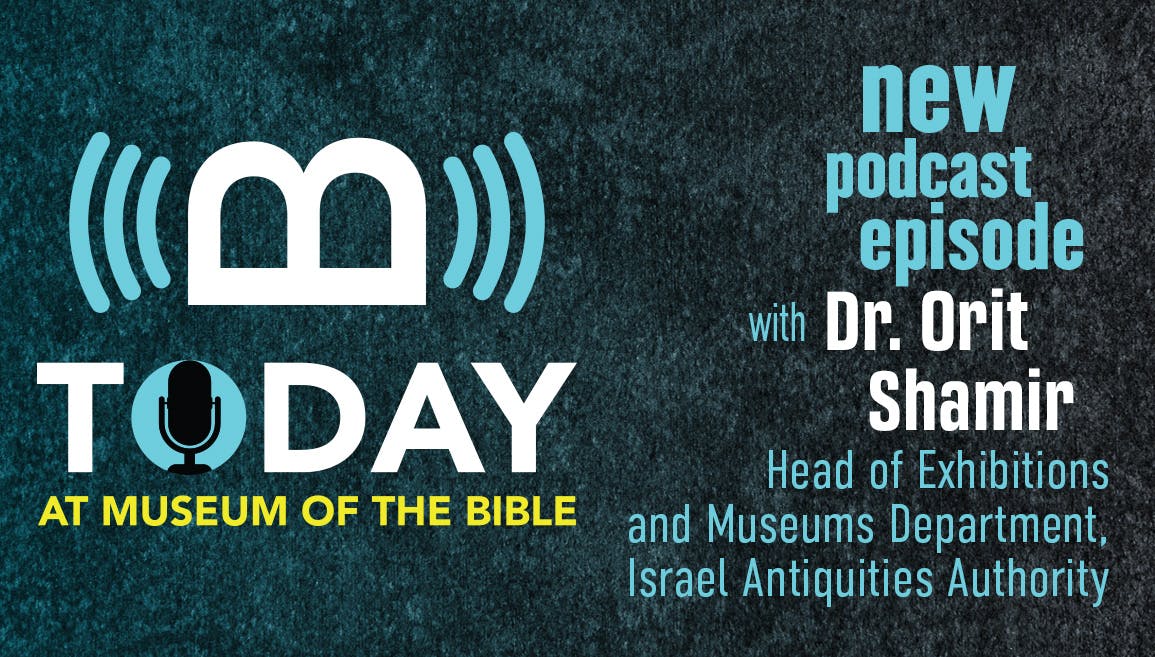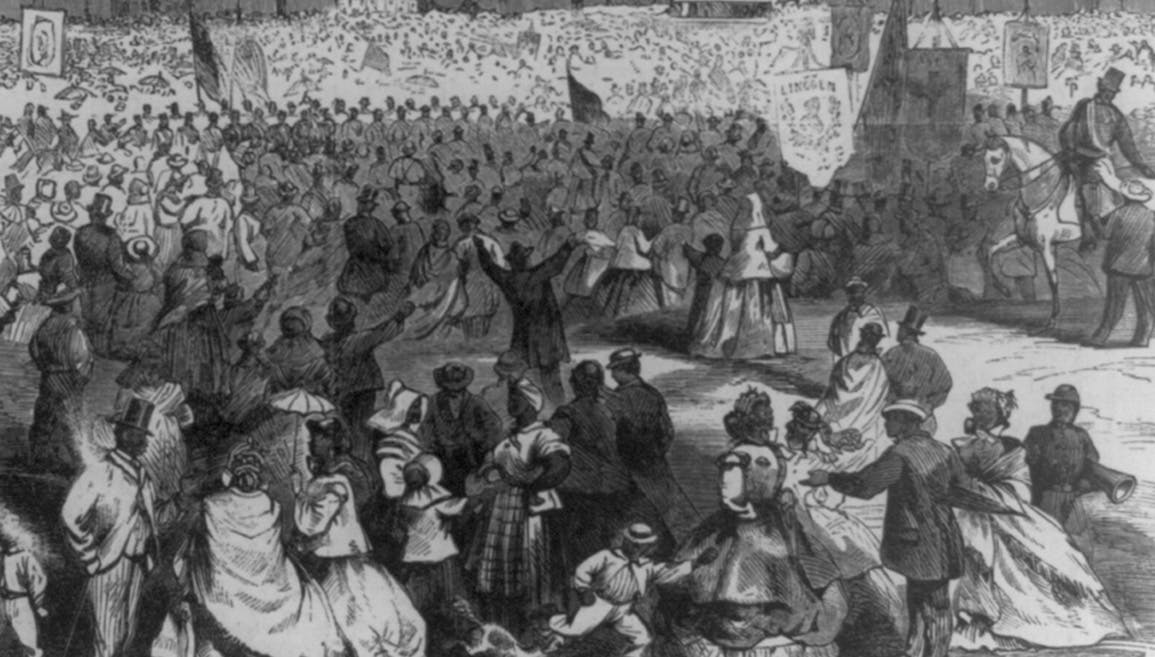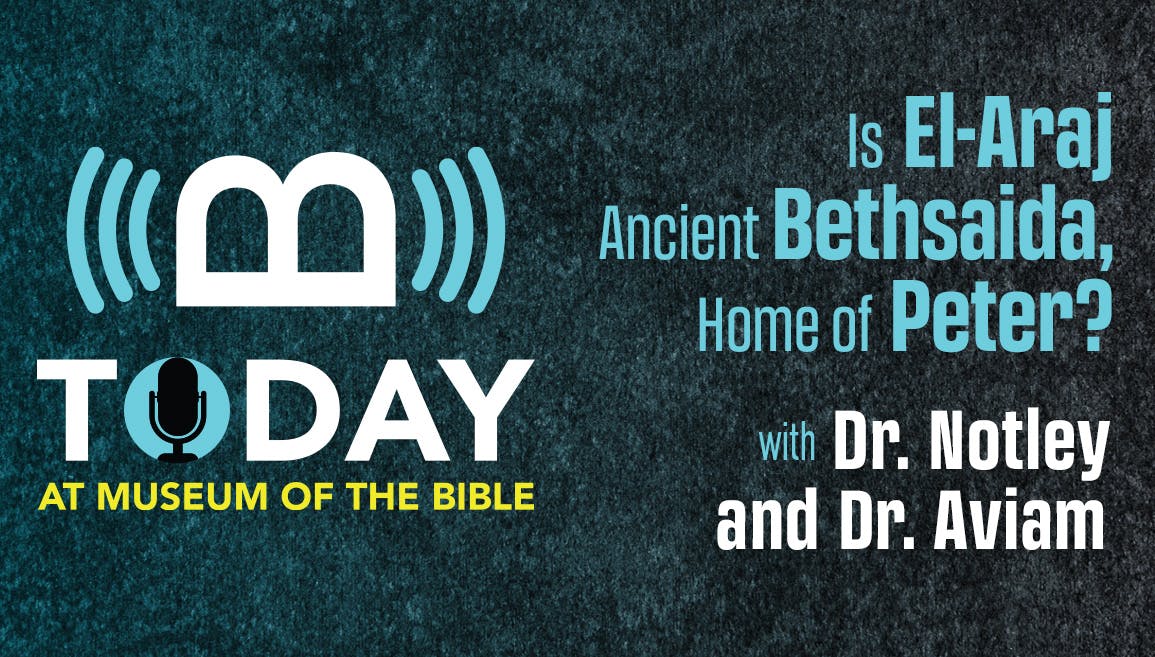From the Podcast: Textiles and the Bible

Recently on our podcast, Charlotte Clay, our director of Marketing and Communications, and Dr. Jeff Kloha, our chief curatorial officer, interviewed Dr. Orit Shamir, the head of the Department of Museums and Exhibits as well as the curator of organic materials for the Israel Antiquities Authority.
The following interview has been edited for clarity and space. To listen to the whole interview, listen to it here on our podcast or you can watch the episode on our YouTube channel.
Charlotte Clay: I'm here today with Dr. Jeffrey Kloha and Dr. Shamir, thank you so much for being with us.
Orit Shamir: I'm happy to be here.
Charlotte: Dr. Shamir holds a PhD from Hebrew University in Jerusalem, and she is the head of the International Exhibitions Department and textile researcher for the Israel Antiquities Authority.
Orit: Very happy to meet the staff here, and I enjoy working with you and planning our future exhibitions.
Jeff Kloha: So maybe a little background, what is the Israel Antiquities Authority? Sounds very impressive.
Orit: I joined the Israel Antiquities 30 years ago, and in 1988, we became an authority. We have something like 600 workers, archaeologists, conservators, researchers, and we are responsible for the archaeological sites in Israel. And we are responsible for 350 archaeological exhibits and museums, because we would like to display all the artifacts to the public and we don't want to keep them at our storerooms.
Jeff: Right. I've been in one of your basements. You have a lot of stuff.
Orit: We have two million objects, and we don't have any dull moments. Every day is an exciting day because we have so many salvage rescue excavations because of the development of the country in new roads, new buildings.
Jeff: Now your area of research is textiles, right? How much material is there and what's your area of research?
Orit: Because of the dry climate in Israel—we have [the] Judean Desert not far away from Jerusalem, the vicinity of the Dead Sea, and also the Negev, the Aravah, the southern part of Israel with the Nabateans, who used to take their spices and perfumes with the camel caravans—thousands of thousands of textiles were found at these areas with the dry climate and, for example, the earliest textiles that we have are dated to the Neolithic period, from the sixth millennium BC, and the textiles are made of linen, and linen is still in fashion today.
Jeff: I have a linen shirt on right now, yeah.
Orit: Right, so people still use linen today, even after 10,000 years. This material is fashionable, and later on, we have textiles from the Chalcolithic period, the third, fourth millennium BC. The textiles are made of linen, and in antiquity, people used linen before they used wool because the fibers of wool were very short, you couldn't use them 6,000 years ago.
Later on, in the Middle Bronze period in Jericho 4,000 years ago, they found wool textiles and now we have another new material who entered to the life of the southern Levant. In Egypt, they used linen for thousands of years because wool was not pure. In Israel, from the Middle Bronze period, they started to use wool. Wool absorbed the dye very well in contrast to linen that you cannot dye. The textiles from the Roman period that are exhibited at your exhibition at the [Museum of the] Bible, they are made of wool. They are colorful and people can come and see them here. The dyes were preserved for 2,000 years, and this is amazing because sometimes when you buy a shirt today, after a few times, it is feathered. In antiquity, they used to dye the fibers, not the threads. So the dye penetrated into the fibers. For thousands of years, textiles were not feathered at all.
Jeff: Don't make things like they used to, right?
Charlotte: That's so interesting. And is it fair to say that only wealthy people would have had clothing that was dyed?
Orit: You're right, because dye is connected to rich people. To dye the textiles, it cost a lot of money, but during the Roman period—the first, second century—the land of Israel, the Jewish population, the Roman population, they used to wear a tunic which was undyed, decorated with two bands descending from the neck opening. But if you are rich, you can buy a tunic that is completely dyed and above the tunic they used to wear the mantle. And if you are very rich, you buy textile which is dyed with the royal purple, the most expensive dye, which was extracted from sea snails from the Mediterranean Sea. You could buy these textiles, but these are very rare in the land of Israel. We have three textiles that are dyed with sea snails, with murex from Timna, the southern part of Israel from the eleventh century BC, from the period of David and Solomon—which are mentioned in the Bible, of course—and later on, [a] few examples from Masada and the Murabba’at.
Jeff: So you mentioned Timna. Tell us what that site is, some of the textiles there, and what the biblical link is to Timna.
Orit: Timna is in the southern part of Israel, 20 kilometers north of Eilat, and the site is a place of the mines of the copper and the production of the vessels that were used in the First Temple. The site began at the Chalcolithic period, so even at the fourth millennium BC, they could produce vessels or artifacts that are made of copper. Later on, during the Egyptian rule, the thirteenth century BC, the Egyptians used this site in order to produce copper, and also they had a temple to Hathor, the goddess of the miners, and at Hathor’s temple, we found colorful textiles. Maybe they belong to the tent that covered the temple. But later on, eleventh century BC, the period of David and Solomon, the tribes who lived at this area extracted the copper and used it for trade and to exchange with other artifacts, and they were rich because we found textiles that were dyed with purple and with red and blue dyes. It is a very important site connected to Museum of the Bible, and it is written in the Bible that the Edomites were under the rule of King David, who probably enjoyed the copper that was produced in this region. And we know from the Bible that King Solomon was very rich, and he probably used these textiles, which were very colorful.
Jeff: Dr. Shamir, when people come to see The People of the Land exhibit from the Israel Antiquities Authority here at Museum of the Bible, what will they see?
Orit: There are 600 artifacts from the Middle Bronze Age until the second century CE, the Roman period. Some of the artifacts are not in the showcases, you can see without any disruption.
Jeff: Yeah, they're not behind the glass or anything.
Orit: It is very impressive and I think this is one of the best exhibitions all over the world displaying the archaeology of the land of Israel, because when you have such a mass of objects, it is not one or two, but it is massive collection of objects, and these are the most important objects. Some of them are very important, and through these objects you can tell the story of the land of Israel. Of course, it is connected to the Bible because some of the stories that are written in the Bible, you can see them at the exhibition. When you talk about Lachish from the seventh century BC, about the Assyrian siege, you can see the artifacts from this war exhibited here. So people can read the Bible and see the artifacts connected to this story.
Charlotte: And it's the only place, I believe, that you can see this kind of collection of artifacts from Israel from these biblical periods in the United States.
Jeff: Yeah, certainly the largest.
Orit: And because it is a young exhibition, it is modern, and people can walk and understand the story and it gives you the feeling that you are staying in the land of Israel.
Jeff: It gets people excited and want to learn more about it. Yeah, it's very impressive. I like to point people to the Baal and Asherah figurines, which you read in the prophets and they're sitting right there in the case.
Charlotte: Thank you so much, Dr. Shamir. This was really fascinating, and we look forward to seeing you at the museum again.
Orit: Very much. Thank you.


